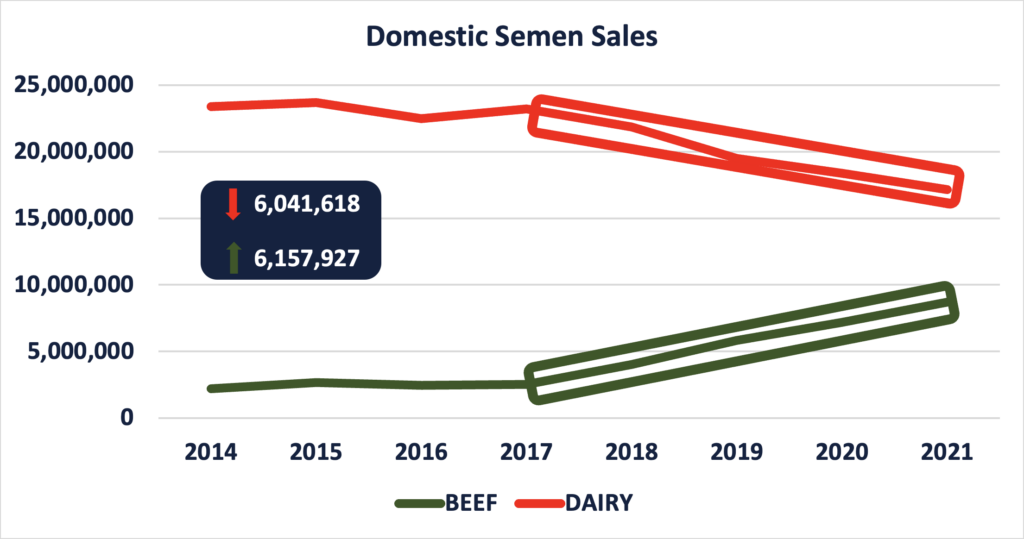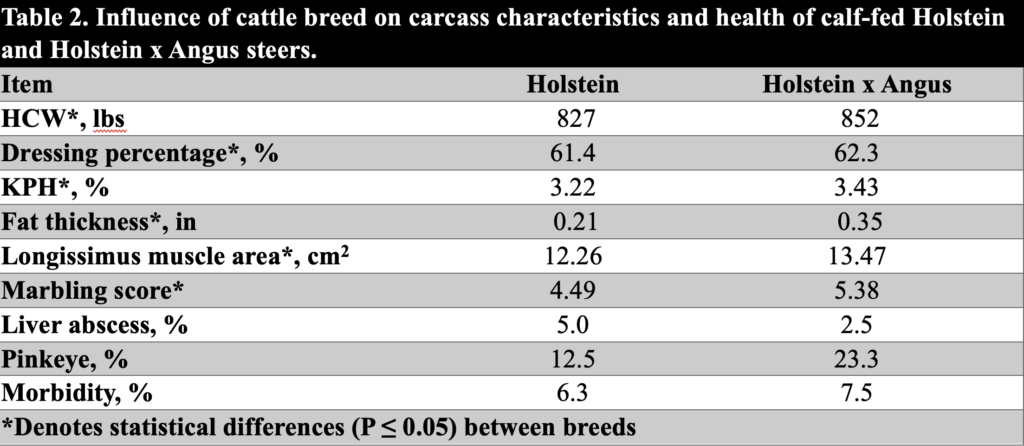According to the most recent National Beef Quality Audit, 16% of the fed cattle in the United States consisted of dairy-type cattle, this is an approximately 60% increase from 2011 to 2016 (Moore et al., 2012; Boykin et al., 2017). Moreover, considering that about 85% of the total dairy herd in the country is composite of Holstein cows (USDA-NASS, 2017), it has been stated that Holstein can be considered the most significant purebred cattle breed fed for slaughter in the U.S. (Schaefer, 2017). However, something has been changing in the beef production from the dairy herd industry.
According to the National Association of Animal Breeders, dairy semen sale reports has decreased about 6 million doses from 2017 to 2021 in dairy semen sales, while a similar increased had been observed in beef semen sale (Figured 1; NAAB, 2023).

It is not possible to affirm that all beef semen sale has been used in the dairy herd. However, several surveys have been conducted across the country to show that there is an increase in beef semen used in dairy cows in this country (Pereira et al., 2022; Felix et al., 2023). A combination of factors has led to these changes, including drivers from the dairy and beef side.
Drivers from dairy side:
- Steady cow numbers.
- Increasing milk production per cow – fewer replacements needed.
- Milk prices decline.
- Enhance reproductive techniques. i.e.: use of sexed semen
- Increased costs to raise replacement heifers.
- Decreased value on male dairy calf and increased value of beef on dairy calf.
Drivers from beef side:
- Continued increase in demand for beef.
- Packers’ restrictions on Holstein.
- Premium paid on beef on dairy crossed by the packer.
Although the increase in beef on dairy cross calves’ supply to the feedlot industry in a fact. There is still limited information on how those cross calves performed in the feedlot. To date, most of the data available is either outdated or from different production systems. However, there are several institutions such as Michigan State, Oklahoma State, Penn State, Texas Tech, UC Davis, and West Texas A&M conducting researching the effects of crossbreeding beef on dairy calves on feedlot growth performance.
Preliminary data from a study conducted at the University of California – Davis, Desert Research and Extension Center are reported bellow on Tables 1 and 2:

There was no effect (P > 0.05) of cattle breed on final body weight and average daily gain (ADG) during the 328 days that cattle were on feed. However, Angus-Holstein crosses had a 3% decrease (P ≤ 0.05) in dry matter intake (DMI), which led to 5% increase (P ≤ 0.05) in grain to feed ration compared to purebred calf-fed Holstein steers.

There was a breed effect (P ≤ 0.05) on all the carcass characteristics presented in Table 2. Compared to the purebred Holstein steers, the crossbred Angus-Holstein steers had heavier hot carcass weights, greater dressing percentages, greater back fat thickness, larger ribeye area, greater marbling score, and greater preliminary yield grade. However, there was no effect (P > 0.05) of cattle breed on liver abscesses, pinkeye, or morbidity.
Take home message!
Angus-Holstein crossbred steers were more feed efficient and had improved carcass characteristics compared to purebred Holstein steers. However, more research is needed to build larger data sets on growth performance of crossbred calf-fed dairy steers compared to purebred calf-fed Holstein steers. Moreover, regardless, of cattle breed, calf-fed steers in the current study had only 3.75% of liver with abscess.


Pedro Carvalho Ph.D.
Assistant Professor and Feedlot Specialist
